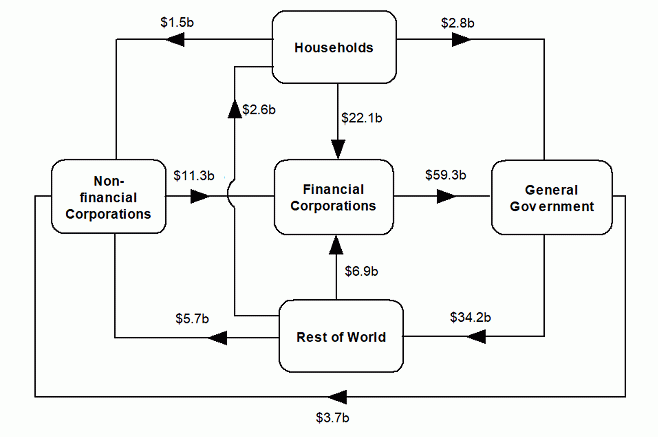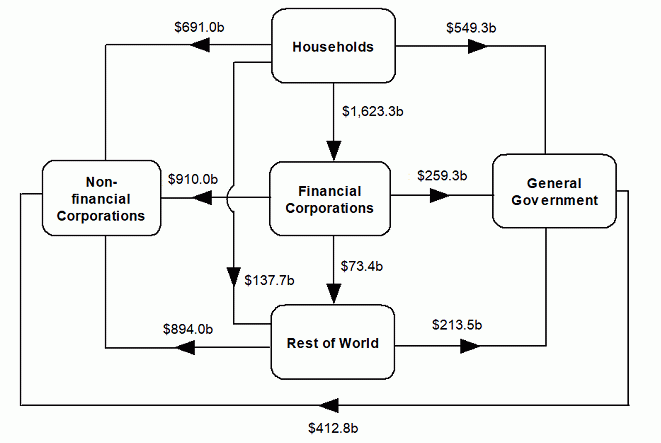March key figures
Financing resources and investment, original, current prices
| Non-financial corporations | Financial corporations | General government | Household | Total National | Rest of world | |||
|---|---|---|---|---|---|---|---|---|
| $b | $b | $b | $b | $b | $b | |||
| Financing resources | ||||||||
| Net saving (a) | -12.7 | 16.4 | 4.2 | 19.1 | 26.9 | -9.2 | ||
| plus Consumption of fixed capital | 42.9 | 3.2 | 11.0 | 31.2 | 88.2 | - | ||
| Gross saving | 30.2 | 19.5 | 15.2 | 50.2 | 115.1 | -9.2 | ||
| plus Net capital transfers | 0.8 | - | -2.0 | 1.0 | -0.2 | 0.2 | ||
| less Statistical discrepancy (b) | - | - | - | - | 6.2 | - | ||
| Total financing resources | 31.0 | 19.5 | 13.2 | 51.2 | 108.7 | -9.1 | ||
| Uses of financing (Investment) | ||||||||
| Capital formation | ||||||||
| Gross fixed capital formation | 46.2 | 3.0 | 17.1 | 35.6 | 101.9 | - | ||
| plus Change in inventories | -2.6 | - | 0.8 | -0.4 | -2.2 | - | ||
| plus Net acquisition of non-produced non-financial assets | -0.1 | - | 0.1 | - | - | - | ||
| Total capital formation | 43.5 | 3.0 | 18.0 | 35.2 | 99.7 | - | ||
| plus Financial investment | ||||||||
| Acquisition of financial assets | 54.0 | 146.1 | 31.4 | 27.6 | 41.1 | 29.7 | ||
| less Incurrence of liabilities | 55.0 | 143.8 | 43.9 | 4.9 | 29.7 | 41.1 | ||
| Net financial investment (Net lending (+) / net borrowing (-)) | -1.0 | 2.2 | -12.5 | 22.7 | 11.4 | -11.4 | ||
| less Net errors and omissions | 11.5 | -14.4 | -7.7 | 6.7 | 2.4 | -2.4 | ||
| Total investment | 31.0 | 19.5 | 13.2 | 51.2 | 108.7 | -1.7 | ||
- nil or rounded to zero (including null cells)
a. Net saving for the Rest of world is the balance on the external income account.
b. The statistical discrepancy is not able to be distributed among the sectors.
National investment experiences largest fall on record
National investment declined by $22.9b this quarter to $99.7b. The fall this quarter was the largest on record and brings investment down to its lowest level since March 2017. In seasonally adjusted terms the decline was $1.1b.
Non-financial corporations investment fell by $11.4b to $43.5b, with private non-financial corporations driving the decline. A run down in inventories contributed to the fall with increased sales of household goods in response to COVID-19 lockdown measures.
Household investment declined by $8.2b to $35.2b, with demand for new housing remaining weak.
General government investment declined by $3.0b to $18.0b, following asset purchases from the public corporations sector last quarter.
Australia at its strongest net lending position
National net lending was $11.4b in March quarter 2020, the strongest net lending position on record, and Australia's fourth consecutive quarter as a net lender. The net lending position was driven by a record net acquisition of financial assets from the rest of the world of $41.1b, which outweighed the incurrence of $29.7b in liabilities.
Australia's net lending position was driven by a $39.6b decrease in non-resident holdings of Australian bonds, due to a major sell off of Commonwealth government bonds and a net maturity of corporate bonds. Authorised deposit taking institutions (ADIs) also made significant purchases of bonds issued by non-residents, further contributing to the strength in net lending.
Australia lent a record $40.9b to non-residents, predominantly made up of loans from ADIs to related overseas entities. This was offset by Australia borrowing record amounts through loans from non-residents ($47.2b), also driven by ADIs.
Households were net lenders, accruing $13.7b in deposits and $18.5b in net equity in reserves of pension funds (superannuation). During the March quarter, the impacts of COVID-19 on superannuation contributions were minimal. Households' loan borrowings were $2.0b for the quarter. Long term loan borrowing ($7.7b) was driven by modest growth in mortgages, while the fall in short term loans borrowing (-$5.6b) was the strongest on record, due to falls in demand for motor vehicles, travel and accommodation, which in part is a response to the pandemic and imposed lock downs.
General government was a net borrower of $12.5b, driven by bond issuance of $14.4b by national general government, and loan borrowing of $18.4b by state and local general governments. These funds were used for bushfire recovery and COVID-19 support packages.
Non-financial corporations were net borrowers of $1.0b. Private non-financial corporations loan borrowing increased by a record $47.0b, as businesses drew down on existing lines of credit . However, a large proportion of these funds were placed in deposit accounts ($46.1b), as businesses sought to ensure sufficient liquidity to cover expenses in anticipation of the impacts of COVID-19 next quarter.

